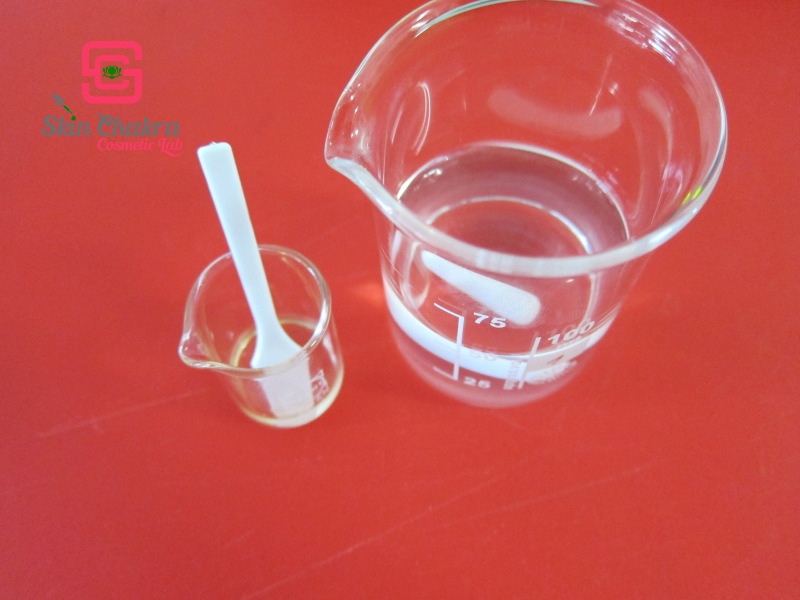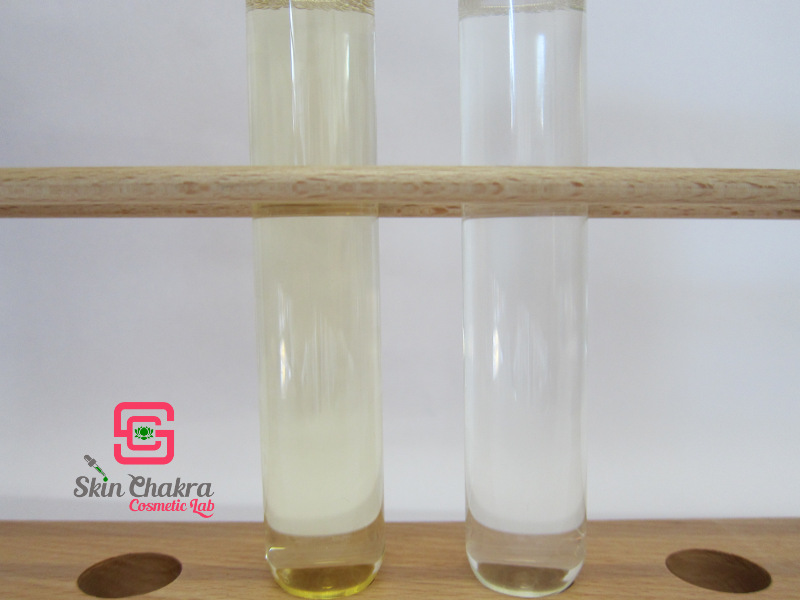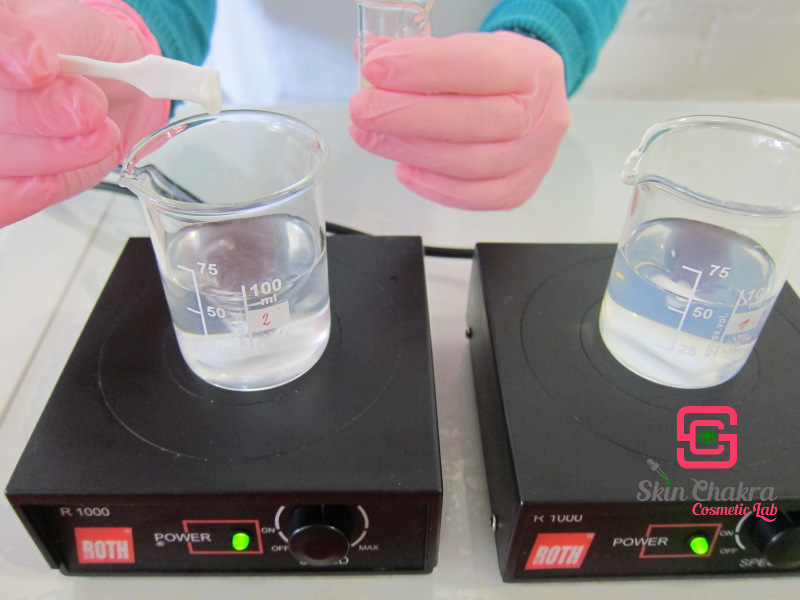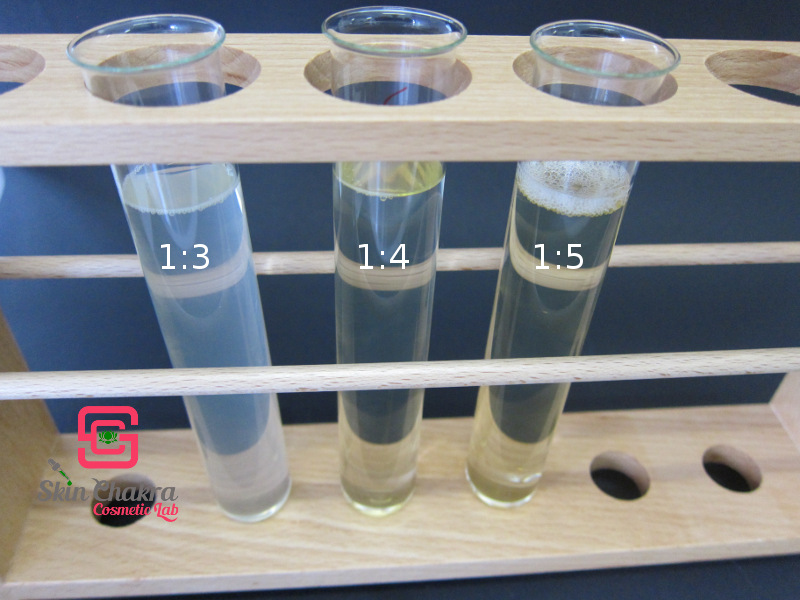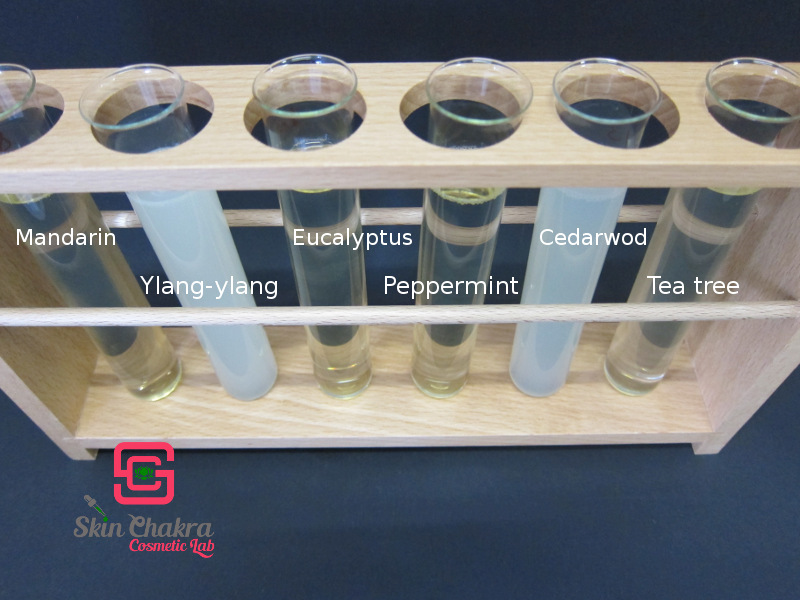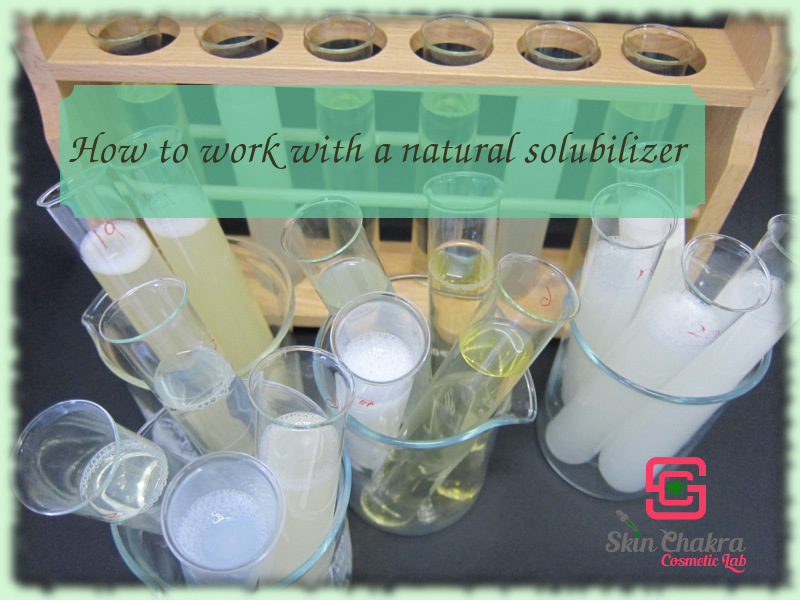
Sonntag, 26. Februar 2017
How to work with a natural solubilizer
Last year I wrote this blog post for Formula Botanica. It seems that new students don't have the habit of digging old blog post and I've observed so many solubilizer related questions, discussions and frustrations during the last couple of weeks that I thought I'll revive and modify last year's blog post.
What is a solubilizer?
As the name reveals, a solubilizer is an ingredient that helps solubilize (make soluble) an ingredient which is otherwise insoluble in a medium. The best and most widely application of a solubilizer (specially in natural cosmetics) is to solubilize and to uniformly disperse an essential oil in water based products.
Keep in mind that a solubilizer in neither a dispersant nor an emulsifier although all three:
- solubilizer
- dispersant
- emulsifier
belong to the surfactant family. An emulsifier helps two immiscible ingredients blend to an emulsion. This is what you do when you make an O/W or a W/O emulsion. The created emulsion usually has a particle size in micrometer range and appears milky.
With an emulsifier, the dispersed phase has a concentration (depending on the emulsifier) between 1-80%. The two immiscible ingredients (or class of ingredients) are usually water (or hydrosols) and plant oils, fatty esters, waxes or fatty acids .(We're considering onyl natural cosmetics and ignore silicones and paraffins)
With a solubilizer, the dispersed phase has a particle size in nano-meter range and hence the overall solution has a clear and transparent appearance. Here we usually solubilize essential oils, fragrance oils or preservatives with oil soluble components (such as benzyl alcohol) in water (or hydrosols). You can hardly use a solubilizer to solubilizer triglycerides (plant oils) or vitamin E in water. The concentration of the to-be solubilized ingredients is usually between 0,1-2,0% (I didn't consider perfumes in this discussion).
Although solubilizers and emulsifiers both belong to surfactants, there is a small difference between them: Solubilizers are more water soluble than emulsifiers (we're talking about O/W emulsifiers) and have a higher HLB value : solubilizer (13-18) vs. emulsifiers 8:16.
Dispersants (which are sometimes mistakenly promoted as solubilizer just to frustrate skincare formulation students when they don't work) are somewhere between solubilizers and emulsifiers. They can disperse very low concentrations of oils (such as vitamin E or even a triglycereide) in water. They don't completely solubilize the oil though (the product isn't completely transparent). They disperse the oil in a translucent to milky solution which remain stable for a reasonable period of time.
Why we need a solubilizer
Almost none of DIY home-crafters and many of small and artisanal manufacturers of natural skin care and perfumes do not use any solubilizers and find it an unnecessary trifle. If you have a look at their products, there is a clear liquid at the bottom with a layer of essential oil on top of the liquid. In best case they have a warning on their instruction for use that recommends the consumer to vigorously shake the bottle before use.
Apart from the fact that such products do not look quite sexy, appetizing and professional, there is a safety and functional problem with such products. In a uniformly solubilized product, the essential oil and the preservative are uniformly dispersed in the product as very small droplets and their concentration is exactly the same through the whole solution from the very first splash to the very last ml till the bottle is completely empty.
If you don't use a solubilizer, even by shaking of the bottle before application (in case the customers thinks on that) the ditribution of the essential oil and the preservative would be quite haphazardly in the solution and would vary from application to application. Now imagine the overdosage or the underdosage of your precious essential oils that you've put into each bottle (the underdosage is bad enough but the overdosage when the dermal limit of the essential oil is exceeded causes sensitization and unwanted reactions). Is that something you want to deliver to your customers?
Natural solubilizers
If you have not yet read our blog post: "Natural solubilizers in comparison", I recommend you go and read it before continuing with this post.
Natural solubilizers are very rare on the market. Most widely applied solubilizers are PEG-40 hydrogenated castor oil and polysorbate-20. Both of them are available under different commercial names and both of them are easy to work with and very forgiving ingredients. Unfortunately both of these ingredients are PEG-derivatives and hence a no-go in natural cosmetics.
Natural solubilizers are slightly more tricky to work with and are significantly more expensive, meaning that you don't want to under dose nor over dose your solubilizer. Overdosage does not only increase the price of your product. Since all solubilizers are surfactants, they create foam in your product and the more solubilizer you use the more foam you create. Foam might be attractive and pleasant in a product like facial cleanser or micellar water but quite unpleasant in a toner or body splash.
This is why you need a suitable dosage of the solubilizer. Remember our golden rule:
As little as possible
As much as needed
To figure out the exact and most suitable ratio between the essential oil and the solubilizer, you need to do some experiments and this is where the frustration begins (some skincare formulation students are extremely impatient and start running before they can walk)
Not only this ratio widely varies for different essential oils, it can even vary for the same essential oil from different suppliers or from different harvests. This is why I strictly recommend that you do some initial tests before jumping into formulating your finished product and make 500 gr of a toner by adding all of your hydrosols, vitamins and extracts to a batch that doesn't work.
As a student of skincare formulation, you've probably have limited access to ingredients and most of you import your ingredients from different parts of the world. It is extremely important (both for your budget as for your nerves) to be careful with your resources and ingredients and to run some elementary experiments before jumping into your final formulation.
Where to start
1- Make small volume tests:
There is no need to make a 100 gr batch for your first tests. You need 20 gr samples to indentify whether a certain ratio of EO:solubilizer would work or not. Scales with a 0,01 gr precision are easily affordable now even to the smalles budgets and a reliable balance should be one of your first purchases if you want to create scientific and reasonable formulations.
Read these interesting and helpful posts about the importance of scales in a cosmetic lab and why you should avoid measuring your EOs in drops:
The right scales for making skincare
Why you should never measure essential oils in drops
2- Make SIMPLE formulations
For the first step, forget about your hydrosols, extracts, vitamins, moisturizers and emollients.
The first step is to find the golden ration of EO:Solubilizer. You don't even need to worry about the preservative at this step.
Blend your solubilizer and EO and add it to water to find out the least concentration of the solubilizer that can solubilize your EO in plain distilled water.
3- Suitable instruments
All you need at this step is beakers (or test tubes) and spatulas (in addition to the scales obviously). You don't need fanciful instruments at this stage (although you can indulge yourself with the luxury of a magnetic stirrer if you already have one in your lab).
Please use suitable beakers and jars. My heart bleeds when I see photos of a 1 litre container with 10 ml of a liquid in it. If you're going to make a 20 ml sample, then you need a beaker with a max. 50 ml volume.
Investing in the right size beakers and vessels is essential for your studies and business.
3- The roght concentration of the EOs
There is no need to test the solubilizer ratio for 5% of an EO when you know that its dermal limits are only 0,5%. Consider the concentration and the ratio of your EO blend in the final product and work with that concentration. (If you're going to use 0,5% of peppermint oil in a cooling body splash then your tests should be based on 0,5% concentration)
4- Finding the golden ratio
Most suppliers usually recommend a dosage range between 1:1-1:10 for EO:solubilizer which is a very broad range. Through our years of experience and working with natural solubilizer, we find a 1:1 ratio very unrealistic. We usually start by a 1:4 ratio and observe the blend. If it looks OK, then we slightly reduce the ratio to see if that would work . If that doesn't look clear we slightly increase the ratio to find the most suitable ratio.
Example and how to:
We've been working with Symbiosolv XC and Symbiosolv clear for years in our lab. These are both natural and plant based solubilizer blends and among our best sold ingredients. You are very welcome to test other solubilizers and the ones you can find by your local suppliers but the methodology could be the same.
The difference between these two solubilizers is that Symbiosolv clear is a gluten free ingredient whereas Symbiosolv XC is derived from wheat glucosides. Another difference is that Symbiosolv XC has a significant golden-yellow colour that might show-up in your final formulation whereas Symbiosolv clear has a very faint colour and almost has no impact on the colour of your finished product.
In the above photo, the left side test tube is Symbiosolv XC and the righ side test tube is Symbiosolv clear. The colour difference is significant. Both samples consist of 1% Mandarin EO + 4% solubilizer.
Unless your supplier specifies others, the solubilizer should be effective at room temperature. It means there is no need to heat up your solubilizer, essential oil or water.
Step by step procedure:
Make 20-25 gr batches at this step.
Make a 1:4 blend of EO:solubilizer in a small beaker. (We're working with 1% EO concentration meaning 1% EO and 4% solubilizer).
Weight your water (100%-(EO+solubilizer)) in another beaker.
Add the EO+solubilizer blend to water in small aliquots. Wait for complete dispersion before each subsequent addition. Blend the mixture for a few minutes.
If the blend looks transparent, reduce the concentration of the solubilizer and see whether it works. If the solution is not transparent, increase the concentration of the solubilizer until you reach a concentration that works.
The above photo shows our samples for a 1% mandarin essential oil with Symbiosolv XC. We started with a 1:4 ratio which was OK. Increase the ratio to 1:5 and there was no significant change. Reduced the ratio to 1:3 and the solution becase cloudy.
We repeated the test with Symbiosolv clear and came to the same results. Only the solutions have a lighter colour compared to Symbiosolv XC.
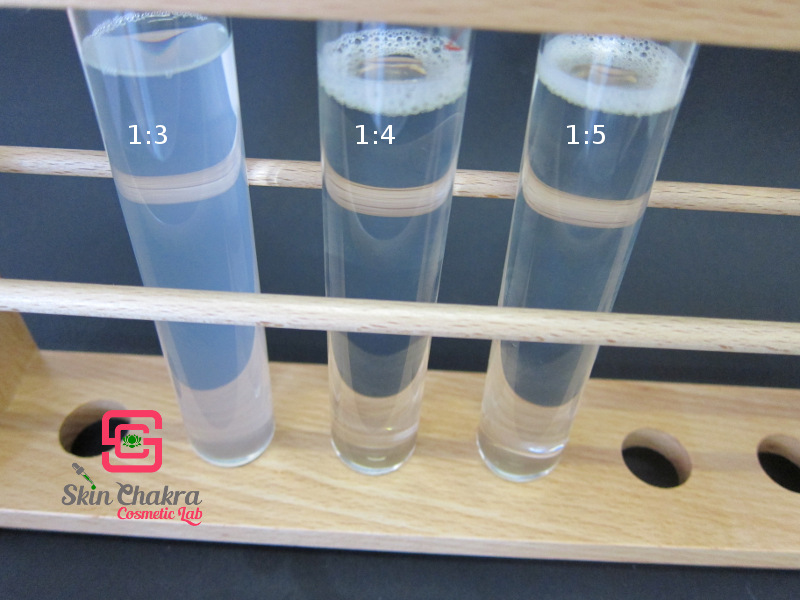 The above photo is for 1% Mandarin EO and Symbiosolv clear in water.
The above photo is for 1% Mandarin EO and Symbiosolv clear in water.
Not all essetial oils are similar
The EO:solubilizer ratio varies from essential oil to essential oil and probably even from supplier to supplier. If you come up with a 1:4 ration for a certain essential oil, it doesn't mean that it would work for all other EOs in your stash.
This is where most skincare formulation students commit mistakes and having tested one EO with success jump to the next EO and make a real batch of a complete formulation assuming that this ratio would work for all essential oils. And guess what? It doesn't always work that simple. When changing your essential oil (even if all other ingredients in the formulation are the same), the optimum EO:solubilizer should be calculated/ tested again.
In the above photo, we've tested 1% of different essential oils with 4% of Symbiosolv XC (a 1:4 ratio for all of the EOs). Look how different they appear. a 1:4 ratio seems to work perfectly for some of the EOs (we may even be able to reduce that to 1:3) whereas for other EOs it isn't sufficient at all and we need to test a 1:5 ratio.
What next?
After we've found the golden ratio, let's say a 1:4 ratio for the EO: solubilizer we need to move to the next step. The next step would be to store your sample for at least 24 hours in the fridge and see whether any turbidity or separation would follow. If this is the case you need to increase the solubilizer:EO ratio and repeat the test again.
If you're lucky enough and the sample is OK then you'll move to the next step which is adding other ingredients.
Preservative
If your preservative is completely water soluble, make a small batch of your final formulation (30-50 gr), add the preservative, adjust the pH and then run the necessary stability tests before scaling up.
If your preservative has some oil soluble components and is not completely water soluble, you'll need to blend the EO and the preservative and find out the optimim/minimum ratio of the solubilizer for the EO+preservative. You may need to increase the concentration of the solubilizer to fully solubilizer the preservative. After finding the golden ratio, run your fridge test and move to the final formulation after your fridge test has been passed succesfully.
Happy end
People (including me) often compare formulation with cooking (although I can not cook). It is not quite correct. When you cook, you can see/taste/evaluate the results almost immediately. When formulating, you can evaluate your success and formulations only after the stability tests are passed. Formulation needs patience (something most of us are not blessed with). Throwing all of your ingredients in a final batch before having passed the necessary tests can (most often) lead to frustration and waste of your precious material (although you'll learn a lot from each mistake and unsuccessful experiment).
Document each step and each change, no matter how silmple and obvious that might appear.
Read this post about the importance of your formulation's diary.
I would love to have your comments and hear about your experience, success and unhappy results as well as seeing your photos. Don't hesitate to send us your questions and comments per mail, posting on our Facebook wall or tagging @skinchakra when uploading your Instagram photos.
